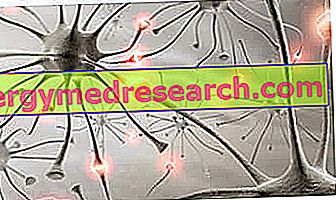Generality
Amyotrophic lateral sclerosis, more commonly known by the acronym ALS, is a rare neurodegenerative disorder that affects the motor neurons of the central nervous system.
ALS sufferers gradually lose control of different vital functions, such as walking, breathing, swallowing and talking.

The causes that cause ALS are still not entirely clear and this makes it difficult to set up an appropriate therapy. In fact, the only currently available treatments only succeed in alleviating the symptoms and slowing the progression of the disease.
What is amyotrophic lateral sclerosis
Amyotrophic lateral sclerosis, also known as ALS, Gehrig's disease or motor neuron disease, is a degenerative disease of the central nervous system . It affects some particular nerve cells, the motor neurons, which guarantee different functions, such as:
- To breathe
- To walk
- Swallow
- Speak
- Hold objects
The result is a progressive loss of control of the most important muscular activities. Death from ALS occurs, very often, due to severe respiratory failure, about 3-5 years after the onset of the disease.
MOTONEURONI AND SLA
Motoneurons, or motor neurons, are cells that originate in the central nervous system (brain and spinal cord); they are used to conduct nerve signals that directly or indirectly control muscles and muscle movement. In fact, with their extensions (axons), the motor neurons reach the peripheral areas of the body. There are somatic motoneurons, which innervate the skeletal muscles directly, and visceral motor neurons, which indirectly innervate the glands, heart and smooth muscles.
Motor neurons of individuals with ALS suffer damage, which gradually becomes more and more extensive, debilitating and ultimately deadly.

Epidemiology
ALS is considered one of the most common neurodegenerative diseases (ie degenerative nervous system, in this central case) in the world, although much less frequent than parkinson's and Alzheimer's disease. In fact, it affects all ethnic groups without distinction
Every year, 1-2 people per 100, 000 become ill with amyotrophic lateral sclerosis: the subjects affected are usually male individuals, in the age group between 40 and 60 years.
In Italy, the SLA is connected to the world of sport, in particular to the world of football: in fact, it caused the tragic death of several famous footballers, such as Stefano Borgonovo and Gianluca Signorini.
Causes
As mentioned above, amyotrophic lateral sclerosis occurs due to a progressive deterioration (or atrophy) of the motoneurons, which ends with their death.
But what determines this gradual neurodegeneration?
At the moment, researchers do not have a precise answer to this question: in fact, although a fraction of cases (5-10%) certainly has a family origin, it seems that in most ALS patients the disease is the result of a combination of several causes.
POSSIBLE CAUSES OF CHANGING
Below are the anomalies held responsible for the SLA. From studies conducted on the subject, it seems that these do not act individually, but in association. However, it is still unclear whether there is a mechanism more important than others or whether there is a sort of consequential link.
- Imbalance in glutamate levels . Glutamate is a chemical neurotransmitter. According to some studies, it appears that the levels of glutamate measured in the cerebrospinal fluid of patients with ALS are higher than normal. This would have a toxic effect on the cells of the nervous system.
- Formation of protein aggregates . The motor neurons of many patients with ALS present unusual aggregates of proteins; these proteins progressively damage nerve cells.
- Accumulation of toxic waste inside the cell . Cells normally produce toxic waste, but these, just as normally, are eliminated by protection systems, such as antioxidants. In the motor neurons of those suffering from ALS, antioxidants are at low and inefficient levels, therefore the toxicity of waste is detrimental to the life of the cells.
- Mitochondria dysfunction . Mitochondria play a vital role in the so-called energy metabolism. In patients with ALS, mitochondria no longer work properly.
- Lack of nutrients . In normal people, the cells of the nervous system feed on so-called neurotrophic growth factors. In people with amyotrophic lateral sclerosis the lack of these essential nutrients has been found, therefore the neurons are destined to gradually degenerate.
- Glia cell dysfunction . The cells of the glia belong to the nervous system and deal mainly with providing support and stability to the motor neurons and not only. Some patients with ALS have shown a glial cell malfunction.
HEREDITARY LATERAL SCIROUSES
During the long studies carried out on ALS, the researchers noted that in some families the disease was recurrent, transmitted from generation to generation. This led to the hypothesis that, for some, the cause was a hereditary genetic mutation .
In fact, subsequent research confirmed this hypothesis and brought to light several responsible genes: the main ones are SOD1, located on chromosome 21, and C9orf72, located on chromosome 9. The C9orf72 gene is at the origin of another pathology, frontotemporal dementia, which characterizes many familial forms of ALS.
What is a genetic mutation?
A genetic mutation is an error present within the DNA, precisely in a trait that forms a gene . Genes have a fundamental biological role: from them, proteins, or biological molecules essential for life, are derived. In genes, there is "written" part of what we are and what we will become.
THE RISK FACTORS
Currently, scientific studies do not only concern the causes mentioned above, but also some environmental risk factors, which seem to play a role in the onset of ALS. These factors are:
- Cigarette smoke . The probability of suffering from ALS seems to be almost double.
- Lead exposure . Those who, due to work reasons, are exposed to lead, seem to be more exposed to amyotrophic lateral sclerosis.
- Military service . According to recent American research, intense military exercises and contact with certain metals and chemicals used for armaments would expose ALS.
Symptoms and Complications
To learn more: Amyotrophic Lateral Sclerosis Symptoms
The symptoms and signs of ALS appear and spread gradually over the whole body, worsening over time. Their maximum manifestation occurs after several weeks, if not months.
In the beginning, the feet, hands and limbs (upper and lower) are affected; then, the disorders extend to the muscles that weaken, to the ability to swallow, to the respiratory functions and to the language.
The classic symptomatology of ALS consists of:
- Difficulty walking
- Sense of weakness in the legs
- Sense of softness on the feet and hips
- Sense of weakness in the shoulders and softness of the arms
- Tremors in the arms
- Inability to grip with the hands
- Slurred speech (dysarthria) and difficulty swallowing (dysphagia)
- Recurrent muscle cramps
- Difficulty keeping your head up high
- Difficulty in maintaining a correct posture
STAGES OF THE DISEASE
ALS is characterized by three symptoms:
- Initial
- Advanced
- The final
Initial stage : most patients, while not experiencing pain, find it difficult to raise their arms above their heads, find it difficult to hold objects and show a tendency to stumble. On the other hand, it is very rare that dysarthria and respiratory disorders appear at this time.
Advanced stage : the situation begins to get richer with pathological signs and becomes more evident: the muscles begin to weaken due to forced use, joint pain starts, drooling due to failure to swallow (dysphagia), one is subjected to continuous yawning (although not tired), you suffer from sudden mood swings, breathing abilities are greatly reduced and the first language difficulties arise (dysarthria).

Figure: a healthy motor neuron compared to a motor neuron affected by ALS. It can be seen that the diseased motor neuron has degenerated and how this causes an atrophy of the innervated muscle.
Final stage: it is the stage in which all the most serious complications of ALS arise. Patients are paralyzed and wheelchair-bound, they no longer breathe independently (they need mechanical ventilation), are no longer able to speak, must be fed via a tube (gastrostomy) and, in some cases, suffer from dementia frontotemporal (a disease of behavior and language).
WHICH PARTS OF THE BODY ARE NOT AFFECTED BY THE SLA?
Patients with ALS usually maintain their mental and thinking abilities: in fact, they are lucid, conscious, know what is happening to them and, very often, communicate with family and friends via a computer.
Besides this aspect, it is also rare that the patient loses control of the bladder, of the intestinal smooth and ocular muscles.
Diagnosis
ALS, especially at the initial stage, is difficult to diagnose, as it resembles, due to symptoms, other pathologies of the nervous system or of the muscles.
How do you realize then the disease?
A correct diagnosis of amyotrophic lateral sclerosis requires, first of all, a thorough physical examination and, subsequently, the following controls:
- Electromyography (EMG)
- Nerve conduction velocity test (NCV)
- Lumbar puncture
- Radiological examinations: nuclear magnetic resonance (NMR) and computerized axial tomography (CT)
- Muscle biopsy
- Laboratory tests on blood and urine
These tests are partly aimed at assessing the nerve activity of the motor neurons and, in part, aimed at the so-called differential diagnosis, or rather the exclusion of all those diseases with symptoms similar to the one investigated.
Main diseases resembling ALS:
- Multiple sclerosis
- Nerve compression
- Slipped disc
- Cervical hernia
- Spinal cord tumors
ELECTROMYOGRAPHY
Electromyography ( EMG ) is used to evaluate the activity of motor neurons and the muscle contraction they trigger. The principle on which this electrical examination is based is rather complicated. Suffice it to say that surface electrodes (applied to the skin) are used to measure the extent of the nervous signal.
Speed? OF NERVOUS CONDUCTION
The nerve conduction velocity test ( NCV ) measures how long the motor neurons take to communicate with the muscles. In other words, it measures how quickly the nerve signals passing through the motor neurons travel. The equipment used resembles that of the EMG.
LUMBAR PUNCTURE
The lumbar puncture consists in collecting liquor (or cerebrospinal fluid ) by introducing a needle between the L3-L4 or L4-L5 vertebrae; subsequently the sample is subjected to laboratory analysis. It takes place in doubtful cases of ALS, to make sure that the symptoms are not due to an inflammatory disease of the nervous system (for example, multiple sclerosis).
It is a mildly invasive procedure. Therefore, it requires the due attention at the time of execution.
RADIOLOGICAL TESTS
ALS could be confused with a tumor of the central nervous system (brain and spinal cord) or a herniated disc.
TAC and RMN dispel any doubt in this regard, as anomalies such as those just mentioned, if present, are easily detectable.
The CT scan, unlike nuclear magnetic resonance, involves exposing the patient to ionizing radiation.
MUSCULAR BIOPSY
Like lumbar puncture and radiological examinations, muscle biopsy is also performed to exclude certain pathologies, similar to ALS.
The biopsy is performed by taking and analyzing a small sample of muscle tissue in the laboratory. Given that ALS is a disease of the central nervous system and not properly of the muscles, the cells of the muscular tissue do not present characteristic abnormalities.
Treatment
ALS is currently an incurable disease.
The only treatments available only serve to slow down the progression of symptoms and delay the onset of complications; in other words, the quality of life of patients improves as much as possible, but do not recover from the disease, which sooner or later results in death.
PHARMACOLOGICAL TREATMENTS
The only drug currently approved by the FDA (Food and Drug Administration), for the treatment of ALS, is riluzole . This medicine would seem to slow the progression of the disease, preserving the motor neurons from the deleterious effects of excess glutamate.
The benefits of treatment vary from patient to patient: some patients respond very well to therapy, extending their existence by several months; others, however, are less receptive and the improvements are barely perceptible.
Riluzole can cause various side effects. In less serious cases, we can observe: nausea, dizziness, a sense of tiredness and gastrointestinal disorders; in severe cases (rare eventuality), severe liver damage may develop.
To learn more: Medicines for the care of ALS »
Side effects of riluzole:
- Nausea
- Weakness
- Reduced lung function
- Dizziness
- Gastrointestinal disorders
- Headache
- Neutropenia
- pancreatitis
- Liver damage
SYMPTOMS CARE
ALS patients, over time, become increasingly less independent and increasingly in need of breathing aids, food, to move from one place to another, to communicate, etc.
Over the past few years, medical and other technology has made it possible to extend the life of patients with amyotrophic lateral sclerosis and improve their quality.
- Mechanical ventilation . The patient is connected, through a tube, to an instrument, which allows him to breathe. The connection is made after a tracheostomy operation, in which a hole is made in the front of the patient's neck and inserted into the breathing tube.
- Physiotherapy . To slow down the onset of paralysis and to promote cardiovascular well-being, it is very useful to stimulate the patient to move (as far as he can and with the most suitable supports) and to practice muscle stretching exercises.
- Occupational therapy . It is expressed in various ways: ranging from adapting the home environment to the needs of the patient, facilitating their inclusion in a social context. The benefits are innumerable, as a patient who does not feel a burden for family members and who feels that he still has a role within a group (family or friends), lives better and longer than expected.
- Language therapy . When ALS is still in its infancy, there are several specialized remedies that allow the patient to be understood and still communicate clearly.

- The artificial feeding (or via tube ). It is possible after gastrostomy surgery, in which a tube is inserted directly into the patient's stomach, to feed him. Artificial feeding is a must, as the ALS sufferer struggles to chew and ingest food, risking suffocation.
- Psychotherapy . People with ALS are lucid people who realize what is happening to them. This could cause a strong sense of discomfort and depression. A valid psychological support, aided by that of family members, can support the patient in the most difficult moments.
WHY IS IT DIFFICULT TO FIND A CARE?
The fact of not knowing yet what the real causes of ALS are affects, and not a little, on the possibilities of treatment. In fact, if the researchers knew what the precise origin of the neurodegenerative disorder is, they could focus their efforts and studies in a precise direction. Unfortunately, this is not yet possible.

Figure: Stefano Borgonovo, a former Italian Serie A footballer, struck by the SLA in 2008 and died for the same in 2013.
Prognosis
The prognosis, for ALS patients, is never positive
Death usually occurs 3-5 years after the onset of symptoms due to respiratory failure.
The quality of life is, as we have seen, strongly conditioned by the symptoms of the disease; the benefits that are obtained with the few treatments available are limited and depend largely on the closeness of family and friends.
Patients who respond better to treatments and who face their situation with determination can also live with ALS for 10 years, but it is very rare.




